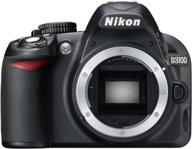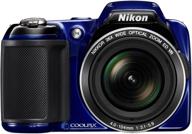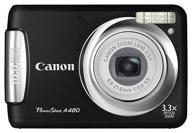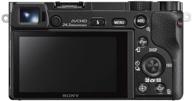
Review on Nikon 1 J1 HD Digital Camera System With 10-30Mm Lens (Black) (OLD MODEL) by Donnie Hickok

It's great for what it is.
There has been a lot of talk about the new Nikon 1 series cameras, a lot of frustration at the size of the CX sensor and the perceived poor quality compared to the larger Sony APS-C NEX cameras. Many enthusiasts were understandably disappointed by this move, wanting the best of all worlds for D3 quality in a point-and-shoot package. The J1 doesn't quite live up to this brand, but if you understand what you're buying and play to the camera's strengths, it's a great device for beginners, enthusiasts and professionals alike. To clarify, I'm rating the J1 primarily for its use *as a camera* - I won't go into much detail on video modes or motion capture. Pros: *As a part-time pro, I bought this camera primarily for its size and the ability to (hopefully) use my F-mount lens collection in the future. The J1 is fantastic in that regard. My first mirrorless purchase was the Sony NEX-3 and overall I was very happy with it, but the size of the lens still made it difficult to carry around. Unfortunately, it's really a matter of physics - there are physical limits to how small you can design a 55mm lens (specifically, it can't be much shorter than 55mm). In fact, the CX format helps the J1 a lot here. Because of the smaller sensor size, it's possible to create equivalent lenses that are significantly smaller and lighter than for the APS-C format. The promise of being able to use high-quality, standard-range zooms (e.g. 17-55 f2.8) as mid-range telephoto lenses is certainly intriguing. There are no free lunches, and obviously wide angle and depth of field suffer here, but I'm hoping Nikon or third parties will sort this out as much as possible. For the time being, however, the J1 with its kit lens is a camera that can be carried not only in your trouser pocket, but also in your coat pocket*. The autofocus system is fantastic, especially in good light. I was particularly impressed with the J1's ability to track an object around the frame. I've been a big fan of Nikon's 3D tracking AF since I first saw it in action on the D300, but the J1 really takes it to the next level. The object tracking mode is fast and very responsive, and once you fix it on something, it stays on target very well. Nikon claims that the J1 and V1 focus faster than the D3, and while I haven't used the D3 for a while, the J1 focuses fast enough (in good light) so I don't doubt that claim.* Image quality is actually quite good Well. I was concerned about how much noise the smaller sensor would have, but so far I've been pretty impressed with the results. JPEG results from the camera aren't outstanding at high ISOs - there's certainly aggressive noise reduction in place - so you'll definitely want to switch to RAW for the best results. ACR does not currently open J1 files, but Capture NX2 does. The ACR 6.6 beta test results published on dpreview.com are encouraging as they come close to the previous generation sensors (D90, D300, etc.). Without file access in my normal (Lightroom) workflow, it's hard for me to do a direct comparison of how much you can extract from a RAW file on the J1 versus other cameras, but so far I'm happy. UPDATE: Lightroom 3.6 beta is out and I've had a chance to play around with a few images I've taken over the past few weeks. Again I was quite impressed. It's not D3. With the default noise reduction in LR, I find the image quality to be much better than my D200, which is quite impressive considering the size of the sensor. It's certainly better than the higher endpoints and shots I've had (Panasonic LX-2, Canon S90 which are quite a few years old to be honest). Things that could be improved: * Interface. The camera tries to do a lot of things for you, and for the most part, it gets the job done. If you try to access things like on a DSLR you might run into some problems. It would be nice to see a Nikon firmware update with the ability to remap some buttons for tasks that are more useful in manual mode, but as with any wish-list feature, don't plan for this when you buy a camera. In general, the interface is no worse than the NEX-3, so I'm not offended. I wish things were more accessible, but the camera is quite comfortable to use as it is.* The high-speed electronic shutter adjustment is very, very limited in terms of what settings you can change. Things you can't control if you want to use high-speed shooting: Program only (no aperture, shutter or manual), ISO (Auto 100-3200 only), Metering (Matrix only), Focus mode (AF-A). only) and focus tracking (only in area mode). I was looking forward to using the high speed mode, but to be honest these limitations make it quite difficult to use with creative control. Image, which is a bit problematic when you're trying to create a series of images. You can take one shot or a series of shots, but in either case you won't be able to use the camera again until the preview disappears, which usually takes 2-3 seconds. Most of the time, this won't make much of a difference for most people, but it does make capturing actions problematic. Simply adding a disable option in the firmware can make a world of difference. Things you might be concerned about but aren't strictly camera critical: using 720p60 and certainly if you're using high-speed video. Maybe the high speed is a bit useless, but don't plan on using it indoors. There just won't be enough light. Video in 720p60 is nice - it's certainly smoother than a lot of other DSLR and mirrorless video, including my experience with the NEX-3. I'm not sure you'll get broadcast quality, but a lot has changed in just a few years.* The smart pick feature works pretty well, but since you can't throw it away, it's hard to know. I haven't used this feature extensively, but when I did I was happy with the images saved. Should I buy J1? It depends. If you're intrigued but not entirely sure you need it, I can wait for the next-gen. If you want to carry around a small, light camera with fairly good image quality, especially if you have a set of Nikon lenses, this would be a good choice. If you're a parent who wants to photograph their kids playing sports, the Nikon J1 combined with a long-range zoom will give you great results. If you want a camera that weighs half a pound, fits in your pocket, has a 25x f2.8 zoom, and gives you noise-free images at ISO 204,800, you'll have to look elsewhere. After all, the J1 is a compromise and doesn't actually claim otherwise. You don't get low-light performance like you'll get with an APS-C camera, but you don't carry ten pounds of gear either. When I bought the J1, my personal philosophy was: If I'm in a situation where image quality is at stake, I'll bring my professional gear. Otherwise, I carry the J1 with me and can shoot scenes, albeit with reduced (but still acceptable) quality, since I have my camera with me and am not at home.
- Pleasant to use
- alt
New products
Comments (0)
Top products in 📷 Digital Cameras

Nikon D3100 DSLR Camera Body (Kit Box) - No Lens Included, International Version with No Warranty

298 Review

Nikon COOLPIX L810 Digital Camera: 16.1MP, 26x Zoom, NIKKOR ED Glass Lens, 3-inch LCD (Blue)

95 Review

Canon PowerShot A480 camera, black

108 Review

Revamped Sony Alpha a6000 Mirrorless Digital Camera: 24.3MP SLR Camera with 3.0-Inch LCD and Power Zoom Lens

103 Review





